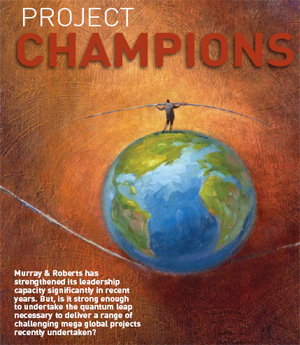|
MARCH 2008 |
 |
|
 |
| Home | | |
Message from CE | | |
Cover story | | |
Major Projects | | |
News | | |
Concessions | | |
Awards | | |
| Currently viewing: Cover story / Next: Major projects |
Cover story

In June 2004, the Murray & Roberts project order book stood at R3 billion. By June 2007 the order book had accelerated to R20 billion. Since then it has grown further to R38 billion, including about R15 billion of MEI and structural work for the power station build program, and the Group confidently awaits final adjudication of a further R10 billion of civil and underground construction work for the same project.
Globally, Murray & Roberts has entered the ‘Premier League’ of construction companies, overcoming intense global competition to secure high profile projects such as the Dubai International Airport and Trump International Hotel and Towers in the prestigious Palm Jumeirah development, also in Dubai.
In South Africa, if the sheer volume of major infrastructure projects appears daunting, their complexity is even more challenging. Many of the projects are unique in a developing economy environment. There is no prior experience of a Gautraintype project in Africa, and the last six-pack power station was completed 15 years ago. But, with the dual challenges of 2010 and power shortages looming large, failure is not an option. Murray & Roberts needs to break the mould if it is to deliver.
Breaking the mould
Although we’ve achieved unparalleled success in winning projects so far, much remains to be done,” says group CE Brian Bruce. Repeatedly over the past few years, we’ve highlighted as our primary business challenge the recruitment and retention of experienced people and leadership. We currently employ about 40 000 people directly, with another 30 000 indirectly employed on our projects.
Over the coming years, we expect our total direct employment numbers to grow substantially, which means we need to raise our game to the level of military deployment.”
But, ultimately, with mega projects where the difference between success and failure is often marginal, responsibility tends to rest on the shoulders of one or two individuals with the energy and determination to drive a project to success, irrespective of obstacles or unexpected reversals.
The importance of corporate leadership in the delivery of major projects has long been recognised. Brian and his colleague Sean Flanagan, with the support of a handful of senior corporate executives in the Group’s domestic and international markets, shoulder much of the responsibility for major projects, from the identification, tendering and negotiation phase, to the implementation.
Ultimately, with mega projects where the difference between success and failure is often marginal, responsibility tends to rest on the shoulders of one or two individuals with the energy and determination to drive a project to success, irrespective of obstacles or unexpected reversals.
A new breed of project leaders
“In recent years, our leadership team has been operating at a far more efficient level than before, but now we need to ratchet up to a new level. To compete with the best, we need to recruit best-ofbreed project managers with specialist global experience and a track record of successful project delivery.
“We are not talking about people with a fatalistic approach that ‘you win some and lose some’, but people who accept in life nothing short of winning every single time,” says Brian.
Securing the services of such individuals will not be easy. World class project managers tend to select companies that themselves have a matching culture of success, a track record of financial strength and the confidence to offer them carte blanche on the project in return for the highest standards of delivery.
And, they are unlikely to be internal appointments. “It takes a different type of person. The typical employee may not be able to lift themselves to new heights to succeed in a difficult project. They base their success not on a single contract, but on their performance over time. They accept that some projects will go wrong, and therefore do not always take full ownership of difficult projects.”
In the past decade, Murray & Roberts has undergone a significant cultural transformation in which employees have been asked to subscribe to clearly defined company values and a unitary culture. Will the Group be able to accept, at a senior level, individuals who do not share that culture, and whose primary objective is not to fit in but to work obsessively on delivering a single project?

A quantum leap
“Hopefully, we can achieve an alignment of the two, but we must be prepared to accept individuals who do not necessarily fit the Murray & Roberts mould,” says Brian.
“That’s the test that we all face as we approach the quantum leap to the challenging space of global mega projects. These new project managers, in order to succeed, will need to know they have the support of the whole team. Without it, we set them up to fail – at our own cost.”
The Group’s unitary approach, in which it deploys its collective strength to take on major projects, is a crucial strategic factor in mega project management. This means that each operation becomes responsible for the Group’s total performance, particularly when it comes to the allocation of scarce resources. “It really is a case of the whole being greater than the sum of the parts. Every project’s success is a consequence of the entire Group’s collective engagement,” Brian says.
One does not have to look far to find an example of a company attempting to make the leap to the Premier League without adequate preparation. Murray & Roberts subsidiary Clough tried it and was quickly relegated. The business failed to recognise that the contracts it had won were beyond its immediate capability. “It has been disastrous for Clough, and we cannot afford to have the same happen at Murray & Roberts.”
Testing organisational fear
Brian offers the anecdote of Michael Schumacher, when the consummate Formula One winner spelled out his secret of success: “He said he drives ‘right on the edge’, where very survival depends not on thinking but purely on one’s senses and intuition. The consequences of a mistake in this space, he said, were potentially ‘catastrophic’”.
Into this heady space, Murray & Roberts will soon be testing the limits of its organisational fear. Whenever a particularly large contract is won, there tends to be a mix of three reactions: those for whom success is a thrill; those who are pleased, but take no ownership; and those who fear the project, or see it as a ‘Trojan horse’ that will ultimately destroy the organisation.
To compete with the best, we need to recruit the very best project managers with specialist global experience and a track record of successful project delivery. We are not talking about people with a fatalistic approach that ‘you win some and lose some’, but people who accept in life nothing short of winning every single time.
“The response of this last group is to introduce policy and processes which essentially hold up or even stop the project. The challenge is twofold: to raise our organisational fear threshold, so that it takes a bigger project to inspire fear, or limit the impact of those who see danger where it doesn’t exist.”
In the past, in the absence of mega projects, the fear threshold was tested only through failure. Murray & Roberts therefore needs to be infused with blooded talent which demonstrates nerves of steel in difficult times. One initiative that is grooming future project managers for greater challenges is the Murray & Robert Graduate Leadership Program, where graduates are being tested in positions of responsibility much earlier in the training process.
All of this does not suggest a slackening of the rigorous risk management processes that Murray & Roberts has implemented in recent years. There is a clear understanding that success in mega projects is critically dependent on early identification and resolution of problems. “Our project leaders need to have the foresight to raise the alarm in time.”

